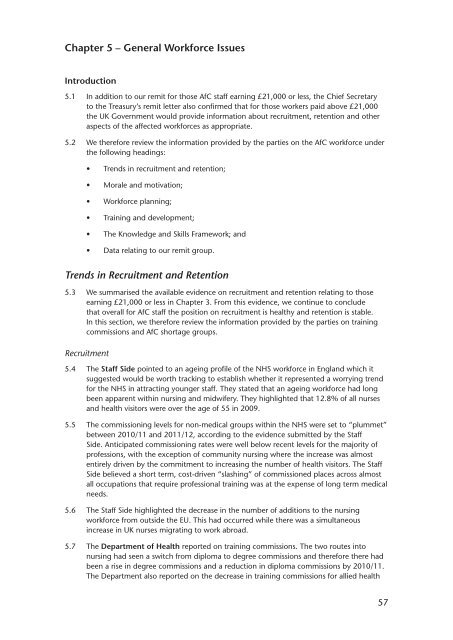NHS pay review body: twenty-sixth report 2012 - Official Documents
NHS pay review body: twenty-sixth report 2012 - Official Documents
NHS pay review body: twenty-sixth report 2012 - Official Documents
You also want an ePaper? Increase the reach of your titles
YUMPU automatically turns print PDFs into web optimized ePapers that Google loves.
Chapter 5 – General Workforce Issues<br />
Introduction<br />
5.1<br />
5.2<br />
In addition to our remit for those AfC staff earning £21,000 or less, the Chief Secretary<br />
to the Treasury’s remit letter also confirmed that for those workers paid above £21,000<br />
the UK Government would provide information about recruitment, retention and other<br />
aspects of the affected workforces as appropriate.<br />
We therefore <strong>review</strong> the information provided by the parties on the AfC workforce under<br />
the following headings:<br />
•<br />
•<br />
•<br />
•<br />
•<br />
•<br />
Trends in recruitment and retention;<br />
Morale and motivation;<br />
Workforce planning;<br />
Training and development;<br />
The Knowledge and Skills Framework; and<br />
Data relating to our remit group.<br />
Trends in Recruitment and Retention<br />
5.3<br />
We summarised the available evidence on recruitment and retention relating to those<br />
earning £21,000 or less in Chapter 3. From this evidence, we continue to conclude<br />
that overall for AfC staff the position on recruitment is healthy and retention is stable.<br />
In this section, we therefore <strong>review</strong> the information provided by the parties on training<br />
commissions and AfC shortage groups.<br />
Recruitment<br />
5.4 The Staff Side pointed to an ageing profile of the <strong>NHS</strong> workforce in England which it<br />
suggested would be worth tracking to establish whether it represented a worrying trend<br />
for the <strong>NHS</strong> in attracting younger staff. They stated that an ageing workforce had long<br />
been apparent within nursing and midwifery. They highlighted that 12.8% of all nurses<br />
and health visitors were over the age of 55 in 2009.<br />
5.5<br />
5.6<br />
The commissioning levels for non-medical groups within the <strong>NHS</strong> were set to “plummet”<br />
between 2010/11 and 2011/12, according to the evidence submitted by the Staff<br />
Side. Anticipated commissioning rates were well below recent levels for the majority of<br />
professions, with the exception of community nursing where the increase was almost<br />
entirely driven by the commitment to increasing the number of health visitors. The Staff<br />
Side believed a short term, cost-driven “slashing” of commissioned places across almost<br />
all occupations that require professional training was at the expense of long term medical<br />
needs.<br />
The Staff Side highlighted the decrease in the number of additions to the nursing<br />
workforce from outside the EU. This had occurred while there was a simultaneous<br />
increase in UK nurses migrating to work abroad.<br />
The<br />
5.7 Department of Health <strong>report</strong>ed on training commissions. The two routes into<br />
nursing had seen a switch from diploma to degree commissions and therefore there had<br />
been a rise in degree commissions and a reduction in diploma commissions by 2010/11.<br />
The Department also <strong>report</strong>ed on the decrease in training commissions for allied health<br />
57
















